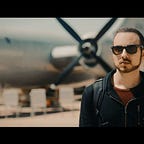Scouting for Big Screen
Each summer at New Life Church, we dig into the word of God using movies as visual representations of biblical principles during our sermon series, Big Screen. We film a couple of these messages on location with Pastor Rick.
Location scouting has its challenges, so we have a few tips to make your experience that much easier!
Finding the Locations
As we prepared the Big Screen shoot for McFarland, USA, we wanted to find local spots that captured the cinematic spirit of the locations in the film. After watching the film, we made a short list of the pivotal locations in the film: a track field with bleachers, a town with hispanic culture, and an orchard.
Some towns were ideal, but the traffic noise would prove impossible to film. Remember that when scouting, your locations should not only work photographically, but also allow you to capture clean sound.
Thankfully, there is a peach orchard in our town that worked great. Finding the bleachers and dirt track proved tough, so we ended up using Google Earth. This is how we found one of our favorite locations for Saving Mr. Banks last year.
We had someone suggest Perryville, Arkansas, as a possibility for our McFarland, USA shoot. So we used the street view in Google Earth and went up and down the streets until we found something.
In the same small town was a Mexican restaurant that had the orange and yellow hues that perfectly resembled the town of McFarland. We drove out to both locations and talked to the owners, and after building relationships with them, we were given permission to use the locations.
Booking the Locations
Every state has its own rules about filming. For example, Arkansas does not require a filming permit with the State, instead you work directly with the owners of the locations. In other states like California and New York, permits are required for filming in addition to getting permission from the owners.
Permits can be expensive, so keep your budget in mind when choosing locations. Contact the local film commission in your area. Every state has one and they can help walk you through the process.
Also, make sure your crew is insured. Most places require this. Talk to the person on your church staff who oversees insurance. It is not very expensive, but you will be really glad you have it.
When it comes to asking for permission to film at a location, bring someone who is good with people. Arkansas does not see many film productions and while the novelty can really help at times, we definitely need people that are good at walking up to a perfect stranger and explaining the project. If people like and trust you, it is a lot easier to secure locations. Pray for favor with the owner, and even ask God for a volunteer or staff member that is good with people to take with you.
Sometimes, we hit it off right away with the location owner. Sometimes we don’t. Most of the time, the people we encounter are open to it. If you sense hesitancy, try to find out which areas to clarify and answer as many questions as possible.
Usually, once people have those questions answered, you will be good to go.
Using the Locations
Our productions went smoothly this year for both shoots due to intentional planning and scouting. Take a DSLR and a zoom lens and create a potential set-up you think will work. Don’t worry about making the image beautiful, but consider the framing and focal length you might use.
Always be flexible. We try to scout locations that closely capture the cinematic spirit of the film. We originally scouted for bleachers at the football stadium. The day we returned to the location for filming with our pastor, we spontaneously asked if there was a locker room available. Fortunately, there was, and it was easy for us to find the right framing and angle. In the end, we went with the locker room instead of the football stadium.
Much of the town of McFarland was seen at night, and there were certain color of lights that came through: blues, greens, and orange. The mexican restaurant we scouted had the orange and yellows that were native to McFarland. For the desired lighting of the night scene, we worked with what the location gave us, using the green neon sign on the restaurant and adding our own blue LED.
Conclusion
Believe in your project, work hard on your project, and find joy in your project. We have an amazing opportunity with these messages to impact eternity for people. Seeing the emotional and spiritual responses during altar call after a Big Screen message reminds us why we do this. It’s amazing what God can do when you move forward with that as your motivation.
The impact even goes beyond the church. As we work with people in these communities, we are mindful that we represent Christ in the way we work. And so, they get to experience and be part of sharing the hope of Jesus. After we film, we pray with location owners and invite them to service.
Location scouting is not only fun, but it’s the beginning of something new, not just for ourselves, but for others as well.
